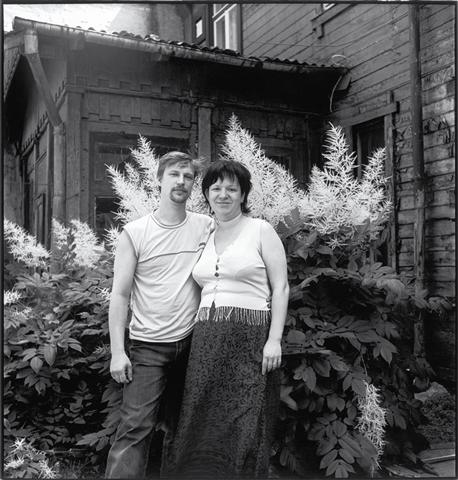|
|
| What the Residents of Amālijas iela 5a are Telling about Themselves Alise Tīfentāle, Art Critic Inta Ruka. "Amālijas iela 5a". 2004-2008 09.01.-08.02.2009. Latvian National Museum of Art | |
 Inta Ruka. Rita Štībele un Uģis Štībelis. Silver print on paper. 2005. | |
| Regardless of what the critics and the public may write and think, the black-and-white photographs of Inta Ruka are a highlight on the Latvian contemporary cultural scene. That's because of the photographer's incomparably friendly and respectful attitude towards the people and the environment portrayed, the technically perfect photographs as well as the perfectly made gelatin silver prints, and the choice of subjects uniquely characteristic of the author. In the catalogue of the exhibition, curator Irēna Bužinska makes a reference to the typological portrait series of different professional classes by August Sander, initiated in 1920s and also known as a "Photo Catalogue of the German People" (as described by Susan Sontag). The approach that is characteristic of Ruka's series and which is similar to scientific research echoes Sander's work, whereas the technique of focusing on a particular small community group in documentary photography has a historic precedent in the book "Let Us Now Praise Famous Men" (1941), with images by Walker Evans and text by James Agee. Over the following decades a similar method has been used by many, and a lot of photographers have been influenced by Evans' approach: at the centre of the series of photographs are three families, their place of residence and their occupation. The "Amālijas iela 5a" series focuses on the inhabitants of one building ("(..) Just one single house. Initially it resembles an ancient sailing ship. Later on it doesn't, still, the inhabitants are like a motley crowd of passengers on a ship moored to time and eternity," - as Jānis Rokpelnis writes in the exhibition catalogue). Yet to look for similar subject matter in Ruka's photographs is beside the point: Evans was a social critic and endeavoured to "discover" the awful truth, i.e., stressing the poverty that his heroes were suffering, but Ruka's work isn't socially oriented and doesn't take the position of critic, there's neither exposure nor allocation of blame. Ruka's work focuses on the individual, who is treated with respect - with a view to learn from him and not to judge or to catalogue. According to Irēna Bužinska: "As always, the artist manages perfectly to retain the balance between the moral and ethical frame-work of characters, or, as described by the artist herself: "deeply personal inner pride", on the one hand, and the human, presumably self-evident imperfections and weaknesses possessed by the same characters, on the other hand." This means that the people in the portraits can be exactly as they are willing to be immortalized therein. Although theories of photography often speak of "camera aggressiveness", it's quite the opposite here - the contents and the at-mo-sphere of the photographs are determined to a large extent by the individuals photographed, and not by the photographer. Everything has been chosen by the residents of Amālijas iela 5a themselves: their appearance, their posture - whether sitting or standing, the location - whether in the apartment or rather in the courtyard by the greenery, the expression - either serious or smiling. The unique "ship" or the building at Amālijas iela 5a is a separate world, in a way a small copy, a microcosm of the city or the state. The black-and-white photographs of Inta Ruka offer us a visual representation of life in this building, meanwhile the essence of life is delivered through the stories told by the residents themselves, as they are the ones who choose the background of the scene, invite the photographer to parties or celebrations, dress up and smile, allow (or don't allow) the photographer into their private space, etc. In this way "Amālijas iela 5a" is both an exhibition of photographs by Inta Ruka, as well as a story about the residents of the building - as told by themselves. /Translator into English: Jānis Aniņš/ | |
| go back | |







